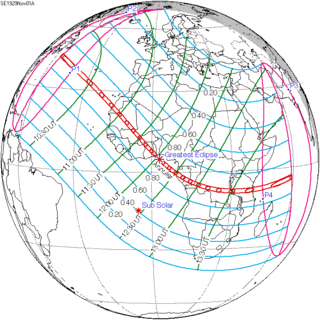| Solar eclipse of November 1, 1929 | |
|---|---|
| Type of eclipse | |
| Nature | Annular |
| Gamma | 0.3514 |
| Magnitude | 0.9649 |
| Maximum eclipse | |
| Duration | 234 s (3 min 54 s) |
| Coordinates | 4°30′N 3°06′E / 4.5°N 3.1°E |
| Max. width of band | 134 km (83 mi) |
| Times (UTC) | |
| Greatest eclipse | 12:05:10 |
| References | |
| Saros | 132 (41 of 71) |
| Catalog # (SE5000) | 9350 |
An annular solar eclipse occurred at the Moon's descending node of orbit on Friday, November 1, 1929,[1] with a magnitude of 0.9649. A solar eclipse occurs when the Moon passes between Earth and the Sun, thereby totally or partly obscuring the image of the Sun for a viewer on Earth. An annular solar eclipse occurs when the Moon's apparent diameter is smaller than the Sun's, blocking most of the Sun's light and causing the Sun to look like an annulus (ring). An annular eclipse appears as a partial eclipse over a region of the Earth thousands of kilometres wide. Occurring about 6 days before apogee (on November 7, 1929, at 11:00 UTC), the Moon's apparent diameter was smaller.[2]
Annularity was visible from Spanish Sahara (today's West Sahara), French West Africa (parts now belonging to Mauritania, Mali, Burkina Faso, and southwestern tip of Benin), British Gold Coast (today's Ghana), French Togoland (today's Togo) including capital Lomé, Portuguese São Tomé and Príncipe (today's São Tomé and Príncipe), French Equatorial Africa (parts now belonging to Gabon and R. Congo) including capital Brazzaville, Belgian Congo (today's DR Congo) including capital Léopoldville, Northern Rhodesia (today's Zambia), British Tanganyika (now belonging to Tanzania) including capital Dar es Salaam, and British Seychelles (today's Seychelles) including capital Victoria. A partial eclipse was visible for most of Africa, Europe, and the Middle East.
- ^ "November 1, 1929 Annular Solar Eclipse". timeanddate. Retrieved 3 August 2024.
- ^ "Moon Distances for London, United Kingdom, England". timeanddate. Retrieved 3 August 2024.
